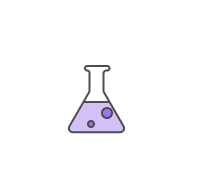What is ALB an acronym for?
Serum can be frozen or refrigerated.
A serum sample is obtained by placing blood in an EDTA or sodium...
What does ALKP stand for?
What is TBIL an acronym for?
BUN stands for
ALT was formerly known as
_________ in the urine of a dog is considered a sensitive indicator of...
When RBCs die, heme is metabolized to ____________ and is carried to...
Hyperbilirubinemia can cause
Decreased number of platelets.
What serum protein helps evaluate hydration, hemorrhage, intestinal,...
Increased BUN concentration may be present if a meal was high in...
The end product of protein metabolism is ______ and is excreted...
A tissue specimen should be suspended in a jar containing formalin at...
Most ALKP in older animals comes from the __________ as bone...
___________ is assayed to determine the cause of jaundice, evaluate...
The _____________ form of bilirubin is found mainly as glucuronic acid...
Serum is plasma from which _________ has been removed. (not clotting...
What enzyme is a sensitive indicator of active liver damage, but does...
The _____________ form of bilirubin is lipid soluble, bound to serum...
The function of __________ is to break down the long-chain fatty acids...
A decrease in _________ may occur in chronic liver dease,...
Bilirubin measured in urine is always the _____________ form unless...
For a tissue biopsy, slabs of tissue should measure no more than ____...
AST should be evaluated in conjunction with _____ for dogs and cats.
What is GGT an acronym for?
The function of _____________ is to break down starches and the...
The mechanical phase of hemostasis is also known as...
Marked elevations in _____ and _____ indicate hepatocellular necrosis....
The denser the aspirated tissue, the smaller the needle and syringe.
What type of procedures are essential for any test...
The absence of trypsin in feces is abnormal.
Some cats with pancreatitis do not have elevated serum lipase levels.
_______________________ refers to increased serum bilirubin levels.
Bleeding from the nares.
AST was formerly known as
Which anticoagulant can be used for more assays included in a routine...
Variation in nuclear size.
Increases in what enzyme may indicate liver, heart, or skeletal muscle...
Horses have higher normal ______ values than other species.
______ is a metabolite of the heme portion of hemoglobin.
Trypsin activity is more readily detectable in _________ than in...
Diabete mellitus is the most common _________ disorder of the...
The pancreas is actually two organs, one _____________ and the other...
Ingestion of toxic substances such as ___________ can create bleeding...
Bleeding into the digestive tract.
DIC is the acronym for
What is another acronym for ALKP?
What two drugs will give a marked increase in ALKP for up to 2 weeks...
The ____________ part of the pancreas secretes an enzyme-rich juice...
A widespread formation of clots within the capillaries.
Adult animals with bone injury or obstructive liver disease may...
What enzyme is a good indicator for small animal fatty liver disease?
In general, if _______ or more nuclear criteria of malignancy are...
Most bleeding disorders found in veterinary species are primary.
Hepatic disease, muscle inflammation or necrosis, and spontaneous or...
Which part of the pancreas is involved with carbohydrate metabolism...
Which of the following are kidney assays?
Increased ____ with normal ____ indicate that the source is NOT the...
BUN levels evaluate _____________ filtration and function.
Nuclei are deformed by other nuclei within the same cell or adjacent...
What type of blood samples are ideal for blood chemistries?...
What are the two phases of hemostasis? (include a comma between...
Von Willebrands disease is a decrease in coagulation factor ____.
What enzyme is found in large amounts in the hepatocytes of dogs,...
What enzyme indicates liver disease or corticosteroid excess?
Superficial hemorrhage of about 1 cm in diameter.
What isoenzyme is present in almost all tissues, particularly...
With a punch biopsy, what size specimen requires no sutures?
What is AST an acronym for?
Bruising
Increased BUN levels include ____________ factors such as shock and...
What is the most common inherited coagulation disorder of...
For centesis, a _______-gauge needle is most commonly used and should...
Most ALKP in young animals comes from ______________ and...
Elevations in ____________ may indicate liver damage,...
Increased _____ with normal to mildly elevated _____ may indicate...
The kidneys produce ______ and ________________.
________________ may result from diabetes mellitus, stress, and...
An increase in ____ will usually accompany an increase in GGT.
_______________ may result from malabsorption, severe liver disease,...
For an aspiration procedure what size needle is appropriate?
Which of the following are liver chemistries?
_________________ are formed in the liver, secreted into the bile, and...
Cytology evaluates cellular architecture.
A sample tube should be immediately labeled with the following:
About ____% of the kidney tissue must be non-functional before...
What is ALT an acronym for?
______________________ is initiated when a blood vessel is ruptured or...
Increased nuclear size.
BAL is the acronym for
What test helps identify bile duct problems and certain tyes of...
The chemical phase of hemostasis is also known as the...
Activated clotting time, buccal mucosal bleeding time, fibrinogen...
Bile acids are mostly reabsorbed in the _______.
What is the most common bleeding disorder of hemostasis in veterinary...
Which of the following are pancreas assays?
Which of the following animals do NOT have bilirubin in their urine?
Pinpoint hemorrhage
















